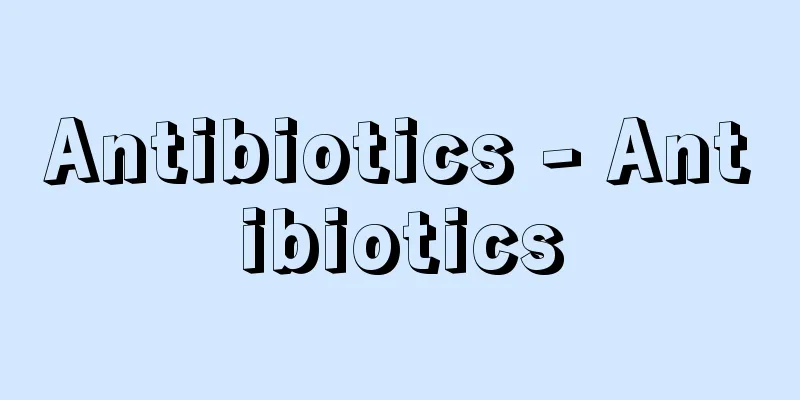Antibiotics - Antibiotics

|
The definition of antibiotics was originally understood as the concept of "antibacterial substances produced by microorganisms," but after a substance that inhibited the growth of malignant tumor cells (cancer cells) was discovered in the culture filtrate of microorganisms, substances obtained from the tissues of higher plants and animals that inhibit the growth of microorganisms were also considered to fall into this category, and the definition of antibiotics came to be broadly interpreted as "substances produced by microorganisms and other organisms that affect the physiological activity of organisms." However, the antibiotics currently used as medicines only refer to those that inhibit or kill the growth of microorganisms such as bacteria, fungi, rickettsia, chlamydia, and viruses, as well as protozoa and malignant tumor cells. The phenomena of symbiosis and antibiotics regarding the mutual growth and proliferation of microorganisms have long been known, but in 1928, during an experiment on the lysis of Staphylococcus aureus, British chemist Fleming observed that a mold that had fallen onto the culture medium by chance was also lysing, which led to the discovery of penicillin. In 1941, microbiologist Waxman, the discoverer of streptomycin, proposed to name "antibiotics" after antibiotics to refer to "chemical substances produced by microorganisms which, at low concentrations, inhibit or destroy the growth of other microorganisms," and the term became popular in his book Antibiotics and Antagonism , published in 1945. This translation is known as antibiotics. [Fumiji Koho] FeaturesAntibiotics exert their therapeutic effect by destroying pathogenic parasites and malignant tumor cells that cause infectious diseases. Therefore, when they act on the living body itself, they cause side effects. With the discovery of antibiotics, the mortality rate from tuberculosis, which was once considered an incurable disease, dropped dramatically, pneumonia and suppurative diseases became almost completely treatable, and intestinal infections such as typhoid, paratyphoid, and dysentery could be easily treated. Taking penicillin as an example, this was because, at first, it had the excellent characteristic of being a medicine that had no effect on the living body and only acted on pathogenic bacteria. Although antibiotics are highly effective, they also have the characteristic of selective toxicity, which means that only certain microorganisms are effective against them. From the perspective of microorganisms, some are sensitive and some are not. In other words, selective action is a feature of antibiotics, and these sensitive and insensitive bacteria are grouped together to form an antibacterial spectrum. Some are only effective against gram-positive bacteria, while others are mainly effective against gram-negative bacteria. Antibiotics also pose the problem of resistant bacteria. If antibiotics are used repeatedly, the microorganisms may develop resistance to the antibiotics, making them ineffective. Even if a microorganism is susceptible to the antibiotics, it may already have acquired resistance and become ineffective. [Fumiji Koho] Research HistoryThere were several reports of the discovery of antibiotics before Fleming, but penicillin was the first to be applied to the human body. After its discovery in 1928, penicillin was not put to any practical use until 1938, when British pharmacologist Florey and chemist Chain succeeded in extracting and isolating it. In 1941, its therapeutic effect against gram-positive bacterial infections (such as suppurative diseases and pneumonia) was confirmed, and research on it progressed rapidly in Europe and the United States. What made penicillin even more famous was a foreign telegraph in January 1944 that reported that it had dramatically cured the pneumonia of then British Prime Minister Churchill (actually a false report). In Japan, too, the whole country made an effort to develop penicillin during World War II, and in 1944 (Showa 19) a product that was tentatively used in clinical practice was completed and named Hekiso. After the war, industrial mass production began under the guidance of the United States. Meanwhile, in 1944, Waxman discovered streptomycin from a species of actinomycete called Streptomyces , and reported that it inhibited the growth of tuberculosis bacteria, marking the beginning of antituberculosis drugs. In 1947, polymyxin B was discovered from the culture medium of Bacillus by Pfizer in the United States, and colistin was discovered in Japan. Also in the same year, chloramphenicol was discovered from the culture filtrate of actinomycetes at the Parke-Davis laboratory in the United States. Fungicidin, which is effective against fungi, was also reported, and was later isolated and named nystatin. The following year, in 1948, chlortetracycline was discovered at Lederly's laboratory in the United States, and fradiomycin was discovered in Japan. In 1950, oxytetracycline was discovered by Pfizer, forming the basis of the tetracycline family. Viomycin was discovered in 1951, erythromycin in 1952, and leucomycin (kitasamycin) and sarkomycin, the first antitumor drug (anticancer drug), were discovered in Japan in 1953 (Showa 28). Kanamycin was discovered in Japan in 1957 and began to be used for tuberculosis as well as gram-negative bacterial infections. At the time, the frequent use of antibiotics led to the emergence of many resistant bacteria, which became a major problem along with shock. Research into the mechanism of kanamycin resistance led to the creation of new aminoglycoside antibiotics. In 1962, cephalothin and cephaloridine, cephalosporin (cephem) antibiotics, were developed, and research into the synthesis of penicillins and cephalosporins became active, leading to the creation of many beta-lactam antibiotics. Among the β-lactams, more cephalosporins have been developed than penicillins. The frequent use of the oral cephalexin cephalexin has led to an increase in the incidence of resistant bacteria and opportunistic infections, leading to the development of second- and third-generation cephalexin cephalexin that are effective against these bacteria. However, because the third-generation cephalexin cephalexin is less effective against gram-positive bacteria, new cephalexin ... Then, methicillin-resistant Staphylococcus aureus (MRSA) appeared as the main cause of hospital infections, and progress was made in the development of antibiotics effective against MRSA. Antibiotics against MRSA include vancomycin, arbekacin, an amino sugar, and teicoplanin, a glycoprotein. Mupirocin is applied as an ointment to the nasal cavity to remove MRSA from the nasal cavity. The frequent use of vancomycin has caused infections caused by vancomycin-resistant enterococci to become a problem, and there is a demand for antibiotics and antibacterial drugs that are more effective against them. A new type of synthetic antibacterial drug, linezolid (Zyvox), was approved for import in April 2001. Its mechanism of action is completely different from that of conventional antibiotics. Thus, it seems that research has gradually shifted from antibiotics produced by microorganisms to research on synthetic antibacterial agents that are chemically synthesized. In fact, quinolone carboxylic acid-based antibacterial agents are being developed one after another. [Fumiji Koho] ClassificationAntibiotics are classified into the following categories based on their chemical structure and applications: (1) β-lactams (penicillins, cephalosporins, etc.), (2) fosfomycin, (3) aminosugars, (4) chloramphenicol, (5) tetracyclines, (6) macrolides, (7) lincomycins, (8) other antibiotics effective mainly against gram-positive bacteria, (9) rifamycins, (10) colistins, (11) antituberculous antibiotics, (12) polyene macrolides, (13) other antifungal antibiotics, and (14) antineoplastic antibiotics. [Fumiji Koho] β-LactamsBased on their chemical structure, they are classified into seven types: penam, cephem, oxacephem, carbacephem, carbapenem, penem, and monobactam. As of 2000, only six types of them were commercially available in Japan: penam, cephem, oxacephem, carbapenem, penem, and monobactam. (1) Penam refers to the penicillins. Benzylpenicillin sodium (penicillin G sodium) is called standard penicillin, and 1 milligram is 1667 international units. It is obtained from the culture medium of Penicillium. It was used for injections because it would decompose if taken orally as is. As a result, there was a demand for penicillin preparations that could be taken orally, and phenoxymethylpenicillin (penicillin V) and benzylpenicillin benzathine were developed. These were called natural penicillins because they were obtained directly from the culture medium of Penicillium. Even today, benzylpenicillin potassium is used as an injection, and benzylpenicillin benzathine is used as an oral preparation. Next, penicillin was developed, which was chemically synthesized using 6-aminopenicillaminic acid, the skeleton of penicillin. This was originally called semi-synthetic penicillin, but is now called synthetic penicillin. There were phenethicillin, propicillin, dicloxacillin, and flucloxacillin for oral administration only, but now only phenethicillin remains. There were oxacillin and cloxacillin for both injection and oral use, and methicillin for injection only, but all of these have been discontinued. These were only effective against gram-positive bacteria, but aminobentylpenicillin (ampicillin) was developed, which became effective against both gram-positive and gram-negative bacteria, and became the basis for the development of broad-spectrum penicillins. Other similarly effective penicillins include amoxicillin and cyclacillin. Ampicillin is not effective against resistant bacteria. Bacampicillin, talampicillin, and lenampicillin are penicillins that have a higher blood concentration and fewer side effects. It has no antibacterial activity by itself, but is absorbed from the digestive tract, hydrolyzed by esterases in the intestinal wall, and becomes ampicillin (a prodrug). In addition, there is pivmelisinam, which is only effective against gram-negative bacteria. Hetacillin, an ampicillin derivative, and carindacillin and carfecillin, which are prodrugs of carbenicillin, were all used orally, but have been discontinued. Penicillins that are also effective against Pseudomonas aeruginosa include carbenicillin, sulbenicillin, ticarcillin, piperacillin, and mezlocillin, all of which were used by injection, but carbenicillin, ticarcillin, and mezlocillin have been discontinued. Aspoxicillin is effective against a small number of bacteria, but has strong antibacterial properties, especially against gram-positive bacteria, and is used by injection. (2) There are two types of cephalosporins and cephamycins. They are classified into first, second and third generation based on their antibacterial spectrum. The first generation of antibiotics have a broad antibacterial spectrum against both gram-positive and gram-negative bacteria, but have less antibacterial activity against Serratia marcescens, indole-positive Proteus, and Enterobacter, and are ineffective against Pseudomonas aeruginosa. These include injectable cephalothin, cefazolin, ceftezole, and cephapirin, and oral cephalexin, cefroxadine, cefaclor, cefatrizine, and cefadroxil. The second generation has increased stability against beta-lactamase (a type of enzyme), making it effective against resistant bacteria, and also exhibits strong antibacterial activity, especially against gram-negative bacilli. These include cefotiam, cefuroxime, and the cephamycin group cefoxime, and cefmetazole, all of which are used for injection. Third generation antibiotics are stable against β-lactamases and have strong antibacterial activity against gram-negative bacteria, Serratia marcescens, Enterobacter, and other bacteria that cause opportunistic infections. These include ceftizoxime, cefotaxime, cefoperazone, cefmenoxime, cefotetan, cefbuperazone, cefpiramide, ceftazidime, and the oxacephem drugs latamoxef and flumoxef. Cefepime, cefazopran, cefixime, cefodizime, cefpirome, cefdinir, ceftriaxone, and cefminox are used by injection, while cefcapene pivoxil, cefteram pivoxil, and cefpotoxime proxetil are taken orally. Newer drugs for oral use in children include cefditoren pivoxil and cefniril. Those that are only effective against gram-negative bacteria include pivmelicinam, ceftibuten, and cefoxitin, and those that show particularly strong antibacterial activity only against Pseudomonas aeruginosa include cefsulodin. Monobactams include aztreonam and carumonam, which are only effective against gram-negative bacteria. The penem family includes faropenem, which is taken orally and is effective against both gram-negative and gram-positive bacteria. The carbapenem family includes meropenem, imipenem, and panipenem; imipenem is used in combination with cilastatin, and panipenem in combination with betamipron. The monovapenem family includes two types, aztreonam and carumonam sodium, which are primarily effective against gram-negative bacteria. The β-lactamase inhibitors clavulanic acid and sulbactam are combined with ampicillin or cefoperazone to form preparations that are effective against resistant bacteria. Examples are sultamicillin tosylate, ampicillin-sulbactam, and amoxicillin-potassium clavulanate, and tazobactam sodium is available in combination with piperacillin sodium. [Fumiji Koho] FosfomycinAlthough its chemical structure is completely different from that of the β-lactams, its mechanism of action is similar in that it inhibits the synthesis of microbial cell walls, and it is used to treat infections caused by gram-negative and gram-positive bacteria, including Pseudomonas aeruginosa. [Fumiji Koho] Amino sugarsThey are classified into three groups based on their indications. Group 1 is mainly effective against Mycobacterium tuberculosis, and includes streptomycin and kanamycin. Group 2 is mainly effective against gram-negative bacteria, and includes kanamycin derivatives bekanamycin, dibekacin, amikacin, ribostamycin, fradiomycin, and paromomycin. Group 3 is effective against gram-negative bacteria, particularly Pseudomonas aeruginosa, and includes gentamicin, tobramycin, micronomycin, sisomicin, astromycin (fortimicin), netilmicin, and isepamicin, and special examples include spectinomycin, which is effective against Neisseria gonorrhoeae, and arbekacin, which is effective against MRSA. Aminosugar antibiotics are not absorbed from the digestive tract, so they can only be administered by injection when a systemic effect is required. Orally, they are used to kill enteric pathogens, or to kill or reduce common enteric bacteria to maintain a germ-free state in patients prone to infections, such as leukemia patients. [Fumiji Koho] Chloramphenicol and tetracyclinesCollectively, they are also called broad-spectrum antibiotics because they are effective against not only gram-positive and gram-negative bacteria, but also rickettsia and chlamydia. Chloramphenicol is rarely used these days because it causes serious side effects such as aplastic anemia. The tetracyclines include oxytetracycline, tetracycline, demethylchlortetracycline, doxycycline, and minocycline, and are moving towards longer-acting drugs with higher blood concentrations. [Fumiji Koho] MacrolidesIts antibacterial spectrum is broad, acting mainly on gram-positive bacteria and mycoplasma, and is also called a medium-spectrum antibiotic. It includes erythromycin, kitasamycin, spiramycin, josamycin, midecamycin, roxithromycin, rokitamycin, clarithromycin, and azithromycin. There are relatively few resistant bacteria. In the same therapeutic group, there is a newer ketolide antibiotic, arithromycin. [Fumiji Koho] LincomycinLincomycin and clindamycin are examples. They are mainly effective against gram-positive bacteria. [Fumiji Koho] Other antibiotics that are primarily effective against gram-positive bacteriaThere are bacitracin, gramicidin S, fusidic acid, and vancomycin, of which bacitracin, gramicidin S, and fusidic acid are primarily used externally as ointments and patches, while vancomycin is used by injection or oral administration and is a glycopeptide antibiotic effective against methicillin-resistant Staphylococcus aureus (MRSA) and used for infectious enteritis. There is also a streptogramin antibiotic quinupristin-dalfopristin combination that is used for vancomycin-resistant Enterococcus faecium. [Fumiji Koho] RifamycinsThere is only one type, rifampicin, which is indicated for tuberculosis, but is effective against both gram-positive and gram-negative bacteria. It is taken orally. [Fumiji Koho] ColistinThese include colistin and polymyxin B. They were often used against Pseudomonas aeruginosa, but more effective antibiotics have been developed, so their use has decreased. However, polymyxin B is taken orally to reduce intestinal bacteria, and is also often used topically. [Fumiji Koho] Antituberculous antibioticsIn addition to streptomycin and kanamycin, rifampicin and cycloserine are taken orally, and capreomycin and enviomycin are injected. Cycloserine is not used much due to side effects. Rifampicin is the mainstream. [Fumiji Koho] Polyenes and macrolidesAntifungal antibiotics include nystatin, amphotericin B, and pimaricin; nystatin is used internally, while pimaricin is used as eye drops and eye ointment. Amphotericin B is used by injection, internally, and externally, and is the only antifungal antibiotic that can be injected. It is said that these are poorly absorbed from the digestive tract. Trichomycin is not currently in use. [Fumiji Koho] Other antifungal antibioticsThey are mainly effective against mycoses caused by tinea fungi and the like; pyrrolnitrin and siccanin are applied externally, while griseofulvin is mainly used internally but can also be applied externally. A newer one is micafungin sodium ("Fungard"). It is derived from a derivative of an active substance with a polypeptide structure produced by filamentous fungi, and is said to be an echinocandin antifungal agent. It has been shown to be effective against mycoses caused by the Aspergillus and Candida genera. [Fumiji Koho] Anticancer antibioticsThese include mitomycin C, actinomycin D, bleomycin, peplomycin, daunorubicin, doxorubicin, aclarubicin, idarubicin, epirubicin, pirarubicin, and the neocarzinostatin derivative zinostatin styramer, and are commonly used in clinical practice. [Fumiji Koho] Mechanism of action(1) Antibiotics that inhibit cell wall synthesis: The outside of the cell membrane is a cell wall made of proteins, lipids, and polysaccharides that protects the bacterial body from the outside. β-lactams and fosfomycin kill bacteria by inhibiting the synthesis of this cell wall. This cell wall does not exist in the cells of higher animals, so antibiotics with this mechanism of action have no effect on living organisms. (2) Cell membrane permeability changers These act on the cell membrane to increase its permeability, expelling substances from the cytoplasm and exerting a bactericidal effect. Examples include polymyxin B and polyene antifungal antibiotics (amphotericin B, nystatin, etc.). (3) Inhibitors of protein synthesis: Protein synthesis is necessary for bacterial growth, and these drugs exert their bactericidal effect by inhibiting this process of protein synthesis. Examples of such drugs include tetracycline, chloramphenicol, erythromycin, and streptomycin. (4) Inhibitors of nucleic acid synthesis: Antibiotics used as anticancer drugs are of this type. They aim to kill cells by inhibiting the synthesis of nucleic acids necessary for cell growth. [Fumiji Koho] Side effectsThe use of antibiotics against infectious diseases has shown dramatic effects, but their frequent use has also led to the frequent appearance of hypersensitivity symptoms such as shock and drug rash. Side effects of antibiotics vary somewhat depending on the type, but here we will list the most common side effects of each. Symptoms of penicillins and cephalosporins include fever, rash, hives, shock, diarrhea, nausea, loss of appetite, eosinophilia, pseudomembranous colitis, vitamin K deficiency, vitamin B deficiency, kidney damage, liver damage, and bacterial replacement. Some cephalosporins, such as cefmetasone, cefoperazone, and latamoxef, have been reported to cause facial flushing, palpitations, dizziness, headache, and nausea when consumed alcohol. Symptoms of amino sugars include the well-known streptomycin-induced hearing loss, i.e., cranial nerve damage (8th cranial nerve damage). Other symptoms include kidney damage, liver damage, rash, nausea, vomiting, loss of appetite, and shock. They also have a muscle relaxant effect. Symptoms of tetracyclines include digestive disorders, pigmentation of the teeth, and liver damage. Lincomycins have been associated with pseudomembranous colitis and digestive disorders, while chloramphenicol has been associated with blood disorders, aplastic anemia, granulocytopenia, and thrombocytopenia, and many have also experienced hypersensitivity symptoms and bacterial replacement. Peptides and polyenes have been associated with renal disorders and hypersensitivity symptoms, while amphotericin B has been associated with nausea, vomiting, and loss of appetite. Antibiotics used as anticancer drugs have been associated with leukopenia, thrombocytopenia, bleeding, anemia, rashes, nausea, vomiting, loss of appetite, fatigue, and heaviness of the head, while bleomycin has been associated with irreversible side effects such as hair loss and pulmonary fibrosis. In general, the overuse of antibiotics leads to the proliferation of resistant bacteria, changes in infectious diseases such as microbial replacement, an increase in antibiotic-resistant infections such as MRSA, and also acts on the living body itself, resulting in undesirable side effects. [Fumiji Koho] productionAntibiotics are chemical substances produced by microorganisms, but as soon as their chemical structure was determined, the manufacturing method quickly shifted to chemical synthesis, including chloramphenicol, which was one of the first antibiotics to be produced by culturing 6-aminopenicillamic acid and 7-aminocephalosporin acid, which have no antibacterial activity against penicillins and cephalosporins, and many new antibiotics were developed by chemical synthesis based on these. Based on research into the theory of resistance to kanamycin, an amino sugar, it became possible to obtain substances that are effective against resistant bacteria by chemically modifying part of it, and most antibiotics, which were originally produced by microorganisms, are now produced by chemical manipulation. Furthermore, antibiotics that were previously screened (selected) by synthesizing many compounds or extracting them from the culture of many microorganisms, are now theoretically created by applying computer molecular design techniques, as in the case of farovenem. Quality control of antibiotic drugs has been carried out for about 50 years according to the "Japanese Antibiotics Drug Standards" (Nippon Antibiotics Standards) based on the Pharmaceutical Affairs Law. However, as the manufacturing technology for antibiotic drugs has improved, their purity has increased, and manufacturing process management such as GMP (Regulations for Manufacturing and Quality Control of Drugs) has also been improved, it was decided to transfer the items listed in the JPAA to the Japanese Pharmacopoeia. In December 2002, all of the items were included in the first supplement to the 14th revised JPAA, and the JPAA was abolished (147 items). The 15th revised JPAA includes 141 items. Newly approved antibiotic drugs (preparations) are listed in "Part 4 of the Japanese Pharmacopoeia's Non-Drug Standards (Antibiotic Drugs)" and are transferred to the Japanese Pharmacopoeia one after another. Old antibiotic drugs that are no longer in use are gradually being removed. Currently, there is little development of new antibiotic preparations. [Fumiji Koho] Pesticide and other usesAs antibiotics became more widely used as medicines, there was a movement to use them to control plant diseases. Streptomycin, chloramphenicol, and oxytetracycline, which were developed as medicines, were used to treat bacterial plant diseases, while griseofulvin was used to control mold (filamentous fungi). At the same time, research and development was also carried out on new antibiotics aimed at controlling plant diseases from the start. Rice blast disease is caused by a type of mold, and traditionally organic mercury was used to control it, but the residual nature and chronic toxicity of organic mercury, as well as environmental pollution, meant that it could no longer be used, and this created an urgent need to develop new pesticides. Research began in Japan in 1953 (Showa 28), and agricultural antibiotics were put into practical use one after another. Japan was the first country to develop new antibiotics that were effective in eliminating diseases of major crops. Compared to chemically synthesized pesticides, antibiotics have the following characteristics: (1) they are effective at low concentrations, (2) their therapeutic effect is greater than their protective effect, (3) they have excellent penetration into the plant body, and (4) they are highly selective. However, they have the disadvantage that repeated use can easily result in the development of resistant bacteria. To give a few examples, blasticidin S and kasugamycin are used to treat rice blast disease, and validamycin is used to treat rice sheath blight disease. Medical antibiotics such as streptomycin and oxytetracycline are also registered for use as pesticides. Another use of antibiotics is as feed additives, which have been widely used worldwide since it was discovered in 1949 that they promote growth when added to feed for piglets and chicks. However, they are not effective for all livestock, and although their efficacy has been experimentally proven, the factors behind their efficacy have not yet been fully identified. Antibacterial agents used in livestock feed are clearly classified as "veterinary medicines" or "feed additives." To ensure their intended use and safety, veterinary medicines are regulated by the Pharmaceutical Affairs Law, while feed additives are regulated by the Act on Assurance of Feed Safety and Improvement of Quality. Veterinary pesticides used to prevent or treat disease and promote growth include tyrocidin (for the treatment of bacterial infections) and hygromycin B (for the prevention or treatment of intestinal parasites). The Food Sanitation Law stipulates that "all foods must not contain antibiotics or chemically synthesized antibacterial substances," and antibiotics and synthetic antibacterial agents for which no residual standards have been set among veterinary medicines must not be contained in livestock products. There have been notable violations of the law involving substances such as nitrofurans and chloramphenicol, the use of which is prohibited in Japan and other countries. Currently, in Japan, 21 types of antibiotics, including chlortetracycline, bacitracin, and destomycin A, are allowed to be contaminated in feed in the official additive specification. Penicillin and streptomycin are removed from the official specification and cannot be used. Veterinary drugs play a major role in the stable supply of livestock and fisheries foods and preventing infectious diseases, but there have also been reports that the amount of antibiotics and synthetic antibacterial agents used for both animal and agricultural use is more than twice that of medical use, and there are concerns about residual toxicity to foods, as well as the emergence of resistant bacteria, and environmental pollution. [Saito Ya] "Antibiotics: Correct Usage and Side Effects" by Mashita Keiaki et al. (Kanahara Medicine Shinsho)" ▽ "Antibiotics: A New Recognition as a Pharmaceutical" by Umezawa Hamao et al. (1981, Pharmaceutical Society of Japan)" ▽ "Antibiotics: A New Recognition as a Pharmaceutical" by Japan Antibiotic Academic Council, "Comprehensive Examination of the Standards for Antibiotics" (1998, Pharmaceutical Jiposha)" ▽ "Japan Antibiotics Drug Standards for Medical Use" by the Ministry of Health, Labor and Welfare (2000, Ministry of Finance Printing Bureau)" ▽ "Japan Antibiotics Drugs Part 4 (Japan Antibiotics Drugs)" (2000, Ministry of Finance Printing Bureau)" ▽ "Antibiotics Drugs Handbook 2000" by the Japan Antibiotic Academic Council" (2000, Jiho)" [Reference Items] | | | | | | | | | | | | Gram- | | | | | | drugs | | | | | | | | | | | | |Source: Shogakukan Encyclopedia Nipponica About Encyclopedia Nipponica Information | Legend |
|
抗生物質の定義は初め「微生物の産生する抗菌性物質」という概念で理解されていたが、微生物の培養濾液(ろえき)から悪性腫瘍(しゅよう)細胞(癌(がん)細胞)の発育を阻止する物質が発見され、さらに高等植物や動物の組織から得られる物質で微生物の発育を抑制するものもこの範疇(はんちゅう)に入れて考えるようになり、抗生物質の定義も、「微生物およびその他の生物によってつくられる物質で、生物の生理活性に影響を与えるもの」と広く解釈されるようになった。しかし、現在、医薬品として用いられている抗生物質は、細菌、真菌、リケッチア、クラミジア、ウイルスなどの微生物のほか、原虫、悪性腫瘍細胞の発育を阻止あるいは死滅させるもののみをさしている。 微生物相互の発育増殖については共生symbioseと抗生antibioseという現象が古くから知られていたが、1928年にイギリスのフレミングがブドウ球菌の溶菌について実験中に、たまたま培地に落ちたアオカビが溶菌をおこしていることを観察し、ペニシリンの発見となった。ストレプトマイシンの発見者で微生物学者であるワックスマンは、1941年に「微生物によってつくられる化学物質で、低濃度でほかの微生物の発育を抑制したり、破壊したりするもの」をantibioseからとってantibioticsと名づけようと提案し、1945年発行の彼の著書『Antibiotics and Antagonism』(抗生物質と拮抗(きっこう)作用)によりこの用語が普及した。この訳語が抗生物質である。 [幸保文治] 特色抗生物質は、感染症などの病原寄生体および悪性腫瘍細胞を死滅させることにより治療効果を現す。したがって生体そのものに作用すると、副作用となって現れる。抗生物質の発見によって、不治の病といわれた結核による死亡率は激減し、また肺炎や化膿(かのう)性疾患の治療も完全に近くなり、さらに腸チフス、パラチフス、赤痢をはじめ腸内感染症もなんなく治療することができるようになった。それはペニシリンを例にとると、当初、生体になんら作用せず、病原菌に対してのみ作用するという医薬品として最高の特徴を有していたからである。 抗生物質の効果はこのように顕著であるが、また選択毒性といって有効な微生物が決まっているという特徴がある。微生物のほうからみれば、感受性のあるものとないものがあるということである。すなわち選択的に作用することが抗生物質の特色であり、これらの感受性のあるものとないものをまとめて抗菌スペクトルがつくられている。あるものはグラム陽性菌にしか有効でなく、あるものはグラム陰性菌に主として有効であるといったことである。 また、抗生物質には耐性菌の問題がある。抗生物質を連用していると、その抗生物質に対して微生物のほうが耐性を得てきて、効果がなくなることがある。感受性のある微生物でも、すでに耐性を獲得して効かない場合もある。 [幸保文治] 研究史抗生物質の発見はフレミング以前にもいくつかの報告があるが、人体に応用されたのはペニシリンが最初である。このペニシリンも1928年に発見されてから、なんら実用に供されることなく推移し、1938年にイギリスの薬理学者フローリーと化学者チェインがこのものの抽出分離に成功し、1941年にグラム陽性菌感染症(化膿性疾患や肺炎など)に対する治療効果が確認され、欧米において急速に研究が進展した。ペニシリンをいっそう有名にしたのは、1944年1月、時のイギリス首相チャーチルの肺炎を劇的に治療したとの外電であり(実際は誤報)、日本でも第二次世界大戦中、国をあげてペニシリンの開発に努力し、1944年(昭和19)中にいちおう臨床に用いられる製品を完成させ、碧素(へきそ)と命名した。そして、戦後、アメリカの指導によって工業的大量生産が行われるようになった。 一方、1944年にワックスマンは、放線菌であるストレプトミセス属Streptomycesの1種からストレプトマイシンを発見し、これが結核菌の発育を抑制することを報告し、抗結核薬の初めとなった。1947年にはアメリカのファイザー社でバチルス属Bacillusの培養液からポリミキシンBが、日本でコリスチンが発見された。また同年、アメリカのパークデイビス社の研究所で放線菌の培養濾液からクロラムフェニコールが発見された。真菌に有効なファンギシジンも報告され、これはのちに単離されてナイスタチンと命名された。翌1948年にはアメリカのレダリーの研究所でクロルテトラサイクリン、日本でフラジオマイシンが発見された。1950年にはファイザー社でオキシテトラサイクリンが発見され、テトラサイクリン系の基礎となった。1951年にはバイオマイシン、1952年にはエリスロマイシンが発見され、1953年(昭和28)には日本でロイコマイシン(キタサマイシン)と、抗悪性腫瘍剤(制癌剤)として最初のザルコマイシンが発見された。そして1957年には日本でカナマイシンが発見され、結核のほかグラム陰性菌感染症にも使用されるようになった。当時、抗生物質の繁用により耐性菌が多く発現し、ショックとともに大きな問題となっていた。カナマイシンの耐性の機序(メカニズム)の研究から、アミノ糖(アミノグリコシド)系の新しい抗生物質がつくられるようになった。1962年にセファロスポリン(セフェム)系のセファロチンとセファロリジンが開発され、ペニシリン系、セファロスポリン系の合成研究が活発となり数多くのβ(ベータ)-ラクタム系抗生物質が誕生した。 β-ラクタム系ではペニシリン系よりセフェム系の方が多く開発されている。 セフェム系の経口剤セファレキシンの繁用により耐性菌や日和見(ひよりみ)感染が多くみられるようになり、これらに有効な第2世代、第3世代のセフェム系が開発された。しかし、第3世代のセフェム系はグラム陽性菌に対する効力が劣ることから、ふたたびグラム陽性菌に強く効くものが使用され、または新たに開発された。 そして、院内感染のおもな原因としてメチシリン耐性黄色ブドウ球菌(MRSA)があらわれ、MRSAに有効な抗生物質の開発へと進展してきた。MRSAに対する抗生物質にはバンコマイシン、アミノ糖系のアルベカシンおよび糖タンパク系のテイコプラニンがあり、ムピロシンは鼻腔(びくう)内のMRSAの除去に軟膏剤として鼻腔に塗布する。バンコマイシンの繁用によりバンコマイシン耐性の腸球菌による感染症が問題となり、さらにこのものに有効な抗生物質・抗菌薬が求められており、新しいタイプの合成抗菌薬リネゾリド(ザイボックス)が、2001年(平成13)4月輸入承認された。作用機序は、従来の抗生物質とまったく異なっている。このように微生物の産生する抗生物質の研究から、しだいに化学的に合成される合成抗菌剤の研究へと移ってきた感がある。事実、キノロンカルボン酸系の抗菌剤が次々と開発されている。 [幸保文治] 分類抗生物質は化学構造上および適応から次のように分類されている。(1)β-ラクタム系(ペニシリン系、セフェム系など)、(2)ホスホマイシン、(3)アミノ糖系、(4)クロラムフェニコール、(5)テトラサイクリン系、(6)マクロライド系、(7)リンコマイシン系、(8)その他主としてグラム陽性菌に有効な抗生物質、(9)リファマイシン系、(10)コリスチン系、(11)抗結核菌性抗生物質、(12)ポリエン・マクロライド系、(13)その他の抗真菌性抗生物質、(14)抗悪性腫瘍性抗生物質。 [幸保文治] β-ラクタム系化学構造上、ペナム、セフェム、オキサセフェム、カルバセフェム、カルバペネム、ペネム、モノバクタムの7種に分類される。2000年(平成12)の時点で日本で市販されているのはこのうちペナム、セフェム、オキサセフェム、カルバペネム、ペネム、モノバクタムの6種である。 (1)ペナムはペニシリン系のことである。ベンジルペニシリンナトリウム(ペニシリンGナトリウム)はスタンダード・ペニシリンと称し、1ミリグラムが1667国際単位である。アオカビの培養液から得られる。これはそのままでは経口投与により分解してしまうので、注射用として使用された。そのため経口投与が可能なペニシリン製剤が求められ、フェノキシメチルペニシリン(ペニシリンV)やベンジルペニシリンベンザチンが開発された。これらはアオカビの培養液から直接に得られたので、天然ペニシリンと称した。現在も、ベンジルペニシリンカリウムが注射剤で、ベンジルペニシリンベンザチンが経口剤で、使用されている。 ついでペニシリンの骨格である6-アミノペニシラミン酸を母体として化学的に合成したペニシリンが開発された。これは初め半合成ペニシリンといわれたが、現在は合成ペニシリンと称している。経口投与のみのものにフェネチシリン、プロピシリン、ジクロキサシリン、フルクロキサシリンがあったが、現在はフェネチシリンのみとなった。注射、経口ともに使用されるものにはオキサシリン、クロキサシリン、注射のみで使用されるものにメチシリンがあったが、すべて販売中止となった。これらはグラム陽性菌のみに有効であったが、アミノベンチルペニシリン(アンピシリン)が開発され、グラム陽性菌・陰性菌ともに有効となり、広域性ペニシリン開発の基礎となった。同様に有効のものにアモキシリン、シクラシリンがある。アンピシリンは耐性菌には効かない。その血中濃度を高くし、副作用を少なくしたものにバカンピシリンとタランピシリン、レナンピシリンがある。そのもの自身には抗菌力はなく、消化管から吸収され、腸壁内のエステラーゼにより加水分解され、アンピシリンとなって作用する(プロドラッグ)。そのほか、グラム陰性菌にのみ有効なピブメリシナムがある。アンピシリン誘導体のヘタシリン、カルベニシリンのプロドラッグであるカリンダシリン、カルフェシリンはいずれも経口で用いられたが、販売中止された。 緑膿菌(りょくのうきん)にも有効なペニシリンに、カルベニシリン、スルベニシリン、チカルシリン、ピペラシリン、メズロシリンがあり、いずれも注射で用いられたが、カルベニシリン、チカルシリン、メズロシリンは販売中止された。アスポキシシリンは有効菌種は少ないが、とくにグラム陽性菌に対し、抗菌力は大であり、注射で用いられる。 (2)セフェム系にはセファロスポリン系とセファマイシン系の2種がある。またその抗菌スペクトルから、第1世代、第2世代、第3世代に分類されている。 第1世代は、グラム陽性・陰性両菌に幅広い抗菌域をもつが、セラチア、インドール陽性プロテウス、エンテロバクターなどに抗菌力が少なく、緑膿菌には効かないもので、注射用のセファロチン、セファゾリン、セフテゾール、セファピリン、経口剤のセファレキシン、セフロキサジン、セファクロル、セファトリジン、セファドロキシルがこれに属する。 第二世代は、β-ラクタマーゼ(酵素の一種)に対する安定性の増大、すなわち耐性菌に有効であるとともに、とくにグラム陰性桿菌(かんきん)への強い抗菌力を示すもので、セフォチアム、セフロキシム、セファマイシン系のセフォキシム、セフメタゾールがあり、いずれも注射用として用いられる。 第三世代は、β-ラクタマーゼに対する安定性とグラム陰性菌、セラチア、エンテロバクターなど日和見(ひよりみ)感染の原因菌に対して抗菌力が強い。セフチゾキシム、セフォタキシム、セフォペラゾン、セフメノキシム、セフォテタン、セフブペラゾン、セフピラミド、セフタジジムなどのほかオキサセフェム系のラタモキセフとフルモキセフなどがある。 セフェピム、セファゾプラン、セフィキシム、セフォジジム、セフピロム、セフジニル、セフトリアキソン、セフミノックスは注射で、セフカペンピボキシル、セフテラムピボキシル、セフポトキシムプロキセチルは内服で用いられる。新しくは小児用内服薬として用いられるセフジトレンピボキシル、セフニジルがある。 グラム陰性菌のみに有効なものにピブメリシナム、セフチブテン、セフォキシチンがあり、とくに緑膿菌のみに強い抗菌力を示すものにセフスロジンがある。モノバクタム系では、アズトレオナムとカルモナムがあり、グラム陰性菌のみに有効である。 ペネム系ではファロペネムがあり、グラム陰性・陽性両方に有効で内服である。カルバペネム系にはメロペネム、イミペネム、パニペネムがあり、イミペネムはシラスタチンと、パニペネムはベタミプロンと配合した製剤が用いられている。モノバタム系にはアズトレオナムとカルモナムナトリウムの2種があり、主としてグラム陰性菌に有効である。β-ラクタマーゼ阻害薬のクラブラン酸とスルバクタムはアンピシリンやセフォペラゾンと配合して、耐性菌にも有効な製剤が使用されている。トシル酸スルタミシリン、アンピシリン・スルバクタム、アモキシシリン・クラブラン酸カリウムがその例であり、タゾバクタムナトリウムはピペラシリンナトリウムと配合した製剤がある。 [幸保文治] ホスホマイシンβ-ラクタム系とは化学構造がまったく異なるが、その作用機序が微生物の細胞壁の合成を阻害する点で類似しており、緑膿菌を含むグラム陰性菌およびグラム陽性菌による感染症に用いられる。 [幸保文治] アミノ糖系適応から三つの群に分類される。第1群は主として結核菌に有効なもので、ストレプトマイシンとカナマイシンがある。第2群は主としてグラム陰性菌に作用するもので、カナマイシンの誘導体であるベカナマイシン、ジベカシン、アミカシン、リボスタマイシン、フラジオマイシン、パロモマイシンがあげられる。第3群はグラム陰性菌のうち、とくに緑膿菌に有効なもので、ゲンタマイシン、トブラマイシン、ミクロノマイシン、シソマイシン、アストロマイシン(「フォーチミシン」)、ネチルマイシン、イセパマイシンがあり、特殊なものとして淋(りん)菌に有効なスペクチノマイシン、MRSAに有効なアルベカシンがある。 アミノ糖系抗生物質は消化管から吸収されないので、全身性の作用を必要とする場合は注射しか有効でない。経口的には腸内病原菌を死滅させるか、または白血病患者のように感染症をおこしやすい患者を無菌状態に保つため、一般腸内細菌を死滅または減少させる目的で使用される。 [幸保文治] クロラムフェニコールとテトラサイクリン系総合して広域性抗生物質とも称される。グラム陽性および陰性の細菌のみならず、リケッチア、クラミジアにも有効であるからである。クロラムフェニコールは、再生不良性貧血など重篤な副作用を示すことから、現在はほとんど使用されなくなった。 テトラサイクリン系ではオキシテトラサイクリン、テトラサイクリン、デメチルクロルテトラサイクリン、ドキシサイクリン、ミノサイクリンがあり、持効性で血中濃度が高いものへと移行している。 [幸保文治] マクロライド系その抗菌スペクトルは、主としてグラム陽性、マイコプラズマに作用して広域性に次いで広いので、中域性抗生物質ともいわれる。エリスロマイシン、キタサマイシン、スピラマイシン、ジョサマイシン、ミデカマイシン、ロキシスロマイシン、ロキタマイシン、クラリスロマイシン、アジスロマイシンがある。耐性菌が比較的少ない。同じ薬効群に、新しくケトライド系のアリスロマイシンがある。 [幸保文治] リンコマイシン系リンコマイシンとクリンダマイシンがあげられる。主としてグラム陽性菌に有効である。 [幸保文治] その他の主としてグラム陽性菌に有効な抗生物質バシトラシン、グラミシジンS、フシジン酸、バンコマイシンがあるが、バシトラシン、グラミシジンS、フシジン酸は軟膏(なんこう)・貼付(ちょうふ)剤として主として外用に用いられ、バンコマイシンは注射および内服で用いられ、メチシリン耐性黄色ブドウ球菌(MRSA)に有効で、感染症腸炎を適用としているグリコペプチド系抗生物質である。また、バンコマイシン耐性エンテロコッカス・フェシウムを適用菌種とするストレプトグラミン系抗生物質キヌプリスチン・ダルホプリスチン合剤がある。 [幸保文治] リファマイシン系リファンピシンが1種あるのみで、結核を適応症としているが、グラム陽性菌・陰性菌ともに有効である。内服で使用する。 [幸保文治] コリスチン系コリスチンとポリミキシンBがある。緑膿菌によく用いられたが、現在ではさらに有効なものが開発されたので、使用量は少なくなった。しかし、ポリミキシンBは腸内細菌を減少させるため内服で用いられ、また外用でもよく用いられる。 [幸保文治] 抗結核菌性抗生物質ストレプトマイシン、カナマイシンのほかに、リファンピシン、サイクロセリンが内服用で、カプレオマイシン、エンビオマイシンが注射で用いられる。サイクロセリンは、副作用もありあまり使用されていない。リファンピジンが主流となっている。 [幸保文治] ポリエン・マクロライド系抗真菌性抗生物質で、ナイスタチン、アムホテリシンB、ピマリシンがあり、ナイスタチンは内用で使用され、ピマリシンは点眼液、眼軟膏として用いられる。注射、内用、外用で使用されるのがアムホテリシンBで、注射のできる唯一の抗真菌性抗生物質である。これらは消化管からは吸収されにくいといわれている。トリコマイシンは現在使用されていない。 [幸保文治] その他の抗真菌性抗生物質主として白癬(はくせん)菌などによる糸状菌症に有効なもので、ピロールニトリン、シッカニンは外用で、グリセオフルビンは主として内用で用いられるが、外用もある。新しいものに、ミカファンギンナトリウム(「ファンガード」)がある。糸状菌の産生するポリペプチド構造を有する活性物質の誘導体より得られたもので、キャンディン系抗真菌剤といわれている。アスペルギルス属およびカンジダ属による真菌症に有効性が認められている。 [幸保文治] 抗悪性腫瘍性抗生物質マイトマイシンC、アクチノマイシンD、ブレオマイシン、ペプロオマイシン、ダウノルビシン、ドキソルビシン、アクラルビシン、イダルビシン、エピルビシン、ピラルビシン、ネオカルチノスタチン誘導体ジノスタチンスチラマーがあり、臨床によく使用されている。 [幸保文治] 作用機序(1)細胞壁の合成を阻害するもの 細胞膜の外側にはタンパク、脂質、多糖類からなる細胞壁があり、外部から菌体を保護している。β-ラクタム系やホスホマイシンはこの細胞壁の合成を阻害することにより細菌を死滅させる。この細胞壁は高等動物の細胞にはなく、したがってこの作用機序(メカニズム)をもつ抗生物質は生体にはまったく作用しない。 (2)細胞膜の透過性を変えるもの 細胞膜に働いてその透過性を増加させ、細胞質内物質を外へ出すことにより殺菌作用を現す。ポリミキシンB、ポリエン系抗真菌性抗生物質(アムホテリシンB、ナイスタチンなど)などがある。 (3)タンパクの合成を阻害するもの 細菌の増殖には細胞内においてタンパクの合成が必要であり、このタンパク合成の過程を阻害することによって殺菌作用を現す。テトラサイクリン、クロラムフェニコール、エリスロマイシン、ストレプトマイシンなどがこの例である。 (4)核酸の合成を阻害するもの 抗悪性腫瘍剤としての抗生物質がこれである。細胞の増殖に必要な核酸の合成過程を阻害することによって細胞の死滅を図る。 [幸保文治] 副作用感染症に対する抗生物質の使用は劇的な効果を示したが、また、繁用されることにより、ショック、薬疹(やくしん)といった過敏症症状が多く現れるようになった。抗生物質の副作用は、その系統によって多少差異があるが、ここではそれぞれの代表的な副作用を記す。 ペニシリン系、セフェム系では、発熱、発疹、じんま疹、ショック、下痢、悪心(おしん)、食欲不振、好酸球増多症、偽膜(ぎまく)性大腸炎、ビタミンK欠乏症、ビタミンB群欠乏症、腎(じん)障害、肝障害、菌交代現象がみられる。セフメタゾン、セフォペラゾン、ラタモキセフなどセフェム系の一部では、飲酒による顔面紅潮、心悸亢進(しんきこうしん)、めまい、頭痛、吐き気を催すことが報告されている。アミノ糖系では有名なストレプトマイシンによる難聴すなわち第8脳神経障害がみられる。そのほか腎障害、肝障害、発疹、悪心、嘔吐(おうと)、食欲不振、ショックもみられる。また、筋弛緩(しかん)作用を有する。テトラサイクリン系では消化器障害、歯牙(しが)への色素沈着、肝障害がみられる。リンコマイシン類は偽膜性大腸炎、消化器障害がみられ、クロラムフェニコールは血液障害、再生不良性貧血、顆粒球(かりゅうきゅう)減少、血小板減少がみられ、過敏症状、菌交代現象も多くみられた。ペプチド系、ポリエン系では腎障害、過敏症状が、アムホテリシンBではとくに悪心、嘔吐、食欲不振がみられる。抗悪性腫瘍剤としての抗生物質では白血球減少、血小板減少、出血、貧血、発疹、悪心、嘔吐、食欲不振、倦怠感(けんたいかん)、頭重などがみられ、ブレオマイシンでは脱毛や肺線維症といった不可逆的な副作用もみられる。 一般的に抗生物質の乱用は、耐性菌を増長させるとともに、菌交代現象といった感染症の変化、MRSAなど抗生物質の効かない感染症の増加を招き、また生体そのものにも作用して、望ましくない副作用が現れる。 [幸保文治] 生産そもそも抗生物質は微生物の産生する化学物質であるが、その化学構造が決定されるや、いち早くその製法が化学合成に移ったクロラムフェニコールをはじめ、ペニシリン系やセファロスポリン系についてはなんら抗菌力をもたない6-アミノペニシラミン酸、7-アミノセファロスポリン酸を培養によって生産し、これをもとにして化学合成を行って、多くの新しい抗生物質が開発されてきた。同じくアミノ糖系のカナマイシンの耐性の理論の研究をもとにして、この一部を化学的に修飾することにより耐性菌にも有効な物質が得られるようになり、本来、微生物の産生物であった抗生物質は、ほとんどが化学的な操作により製造されるようになり、そして、従来多くの化合物を合成したり、多くの微生物の培養により抽出したりしてスクリーニング(選択)してきた抗生物質も、ファロベネムの例のごとくコンピュータ分子設計手法を応用して理論的に創製されるようになった。抗生物質医薬品の基準は、薬事法に基づき「日本抗生物質医薬品基準」(日抗基)により約50年間品質管理が行われてきた。しかし、抗生物質医薬品の製造技術が進んで純度も高くなり、GMP(医薬品の製造及び品質管理規則)などの製造工程管理も充実してきたので、日抗基・収載品目の日本薬局方への移行が決定し、2002年(平成14)12月、第十四改正日本薬局方の第一追補にすべて収載され、日抗基は廃止された(147品目)。第十五改正日本薬局方には141品目が収載されている。新たに承認された抗生物質薬品(製剤)は「日本薬局方外医薬品規格第四部(抗生物質医薬品)」に収載され、順次日本薬局方に移行される。そして、古くて使用されなくなった抗生物質医薬品は徐々に削除されている。現在は新抗生物質製剤の開発は少なくなっている。 [幸保文治] 農薬その他としての用途抗生物質の医薬品としての発展に伴って、植物の病気の防除に抗生物質を利用する動きがおこった。医薬品として開発されたストレプトマイシン、クロラムフェニコール、オキシテトラサイクリンなどが細菌を病原菌とする植物の病気に対して、また、グリセオフルビンがカビ(糸状菌、真菌)の防除用として利用された。 その一方で、初めから植物の病気防除を目的とした新しい抗生物質の研究開発も行われた。イネのイモチ病は一種のカビでおこり、従来は防除として有機水銀が用いられていたが、有機水銀の残留性と慢性毒性そして環境汚染が問題となって使用不可となり、新農薬の開発が急務とされたことなどが、その背景にある。日本では1953年(昭和28)に研究が開始され、次々と農業用抗生物質が実用化された。主要作物の病害駆除に有効な新抗生物質を開発したのは、日本が初めてである。 抗生物質は化学合成農薬に比べて(1)低濃度で有効、(2)保護効果より大きい治療効果、(3)植物体内へのすぐれた浸透性、(4)高い選択性、などが特徴としてあげられるが、欠点は連用により耐性菌が出やすいことである。 いくつか例をあげると、イネのイモチ病にはブラストサイジンSやカスガマイシン、イネの紋枯(もんがれ)病にはバリダマイシンが使われており、またストレプトマイシン、オキシテトラサイクリンなどの医療用抗生剤も農薬用として登録されている。 抗生物質のその他の用途として、1949年に子ブタやひなどりなどの飼料に加えると成長を促進する効果が発見されて以来、飼料添加物として世界的に広く利用されている。しかし、すべての家畜に有効なわけではなく、その薬効についても、実験的に効果が立証されているとはいえ、要因はまだ十分に確認されてはいない。 家畜飼料に添加して用いられる抗菌剤は「動物用医薬品」と「飼料添加物」に明確に分類され、使用目的や安全性を確保するために、動物用医薬品は薬事法で、飼料添加物は「飼料の安全性の確保及び品質の改善に関する法律」で規制される。 病気の予防治療と成長促進を目的とした動物専用農薬には、チロシジン(細菌感染治療)、ハイグロマイシンB(腸内寄生虫の予防治療)などがある。 食品衛生法には「全ての食品について、抗生物質又は化学的合成品たる抗菌性物質を含有してはならない」という規定があり、動物用医薬品のうち残留基準が設定されていない抗生物質、合成抗菌剤については、畜産物に含有してはならない。ニトロフラン類やクロラムフェニコールといった日本および諸外国で使用が禁止されている物質の違反が目だっている。 現在、日本では飼料安全法に基づいてクロルテトラサイクリン、バシトラシン、デストマイシンAなど21種類の抗生物質が添加物公定書で飼料への混入が認められている。ペニシリンやストレプトマイシンは公定書から削除され使用できない。 動物用医薬品等は畜産食品および水産食品の安定的な供給や、伝染病の防止に大きな役割を果たしているが、動物用と農業用をあわせた抗生物質および合成抗菌剤の使用量が医療用使用量の2倍以上であるとの報告もあり、食品への残留毒性をはじめとして、耐性菌出現の問題、環境汚染等が懸念される。 [斎藤 彌] 『真下啓明他著『抗生物質――正しい使い方と副作用』(金原医学新書)』▽『梅沢浜夫他著『抗生物質――医薬としての新しい認識』(1981・日本薬学会)』▽『日本抗生物質学術協議会編『日本抗生物質医薬品基準解説』(1998・薬業時報社)』▽『厚生省編『日本抗生物質医薬品基準』(2000・大蔵省印刷局)』▽『厚生省編『日本薬局方外医薬品規格第四部(日本抗生物質医薬品)』(2000・大蔵省印刷局)』▽『日本抗生物質学術協議会編『抗菌性物質医薬品ハンドブック2000』(2000・じほう)』 [参照項目] | | | | | | | | | | | | | | | | | | | | | | | | | | | | | | |出典 小学館 日本大百科全書(ニッポニカ)日本大百科全書(ニッポニカ)について 情報 | 凡例 |
<<: Rehabilitation - Kouseihogo
Recommend
Three Sovereigns and Five Emperors
Legendary emperors of ancient China. It is said t...
Sedimentary cycle
A sedimentary phenomenon in which several strata a...
Nāṣir Khusraw
1003‐61 Persian poet. Born in a region of Balkh, h...
intermediate phase
…A compound formed between metallic elements, it ...
Cornu, P. (English spelling) CornuP
…In the 15th century, Leonardo da Vinci left sket...
Cavalcanti - Guido Cavalcanti
Italian poet. Born into a noble family in Florenc...
Gloves - gloves
A general term for a bag-shaped hand covering wor...
Ethelbelft - Ethelbelft
…The seven kingdoms of Kent in the southeast (fou...
benzylbenzene
…An aromatic hydrocarbon, also known as benzylben...
Iwami Land Survey
Land surveys were conducted by Okubo Iwami no Kam...
Cottesloe
…The new theatre designed by D. Razdan was partia...
Themba, C. (English spelling) ThembaC
...The same can be said of writers such as Peter ...
Normative theory - kihansetsu
...Therefore, in civil procedural law, there is f...
Epipomponia hagoromo (English spelling) Epipomponia hagoromo
…[Hiroshi Inoue]. … *Some of the terminology expl...
Allen, GC - Allen
...Historian James Murdoch (1856-1921), writer L....







![Kasari [town] - Kasari](/upload/images/67cb31ae33b82.webp)

